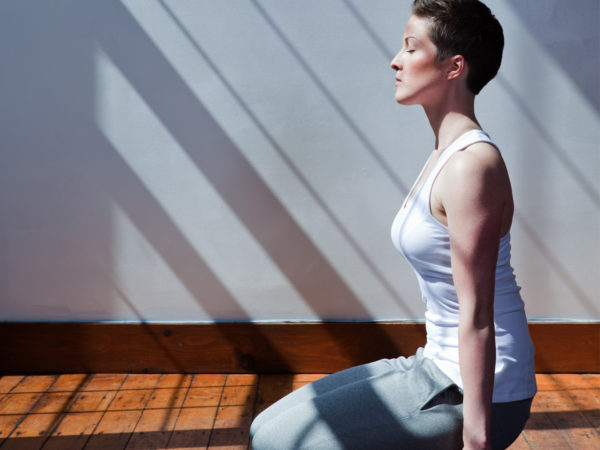Hero Pose

“The Hero Pose provides a deep stretch for the thighs, hips, and ankles. It is among my favorite poses.” – Andrew Weil, M.D.
Description & History
The Hero Pose is a sitting pose that is a common starting point for several other yoga poses. During the pose, the practitioner kneels and sits on the floor with lower legs to the sides of the body. It is used as a way to relax the body, allow for breathing exercises, and improve flexibility in the thighs, knees, and ankles. The Sanskrit name, Virasana, comes from vira meaning man or hero and asana meaning posture. The Hero Pose is also performed as an alternative to other sitting poses such as the Lotus Pose.
How to Perform Hero Pose
- Begin by kneeling on the floor with inner knees together and your feet pointed directly behind you and away from your knees. Rest your buttocks on your calf muscles and straighten your spine.
- Exhale and spread your feet slightly wider than your hips to allow for your buttocks to rest comfortably on the floor. Firm your shoulder blades against your back and widen your collarbones to allow for your chest and lungs to expand.
- Rest the backs of your hands on your thighs and touch your thumb and index finger together, creating a small circle with your fingers.
- When first starting the Hero Pose, hold the pose for 30 seconds to one minute. Once you are comfortable, increase the time you stay in the pose up to five minutes.
- To come out of the pose, press your hands into the floor and lift your buttocks up until you can safely bring your feet under your body to stand.
Potential Health Benefits
- Stretches and improves flexibility of hips, thighs, knees, and ankles
- Improves digestion and may help relieves symptoms of menopause
- Provides relaxing and meditative benefits
- Therapeutic for high blood pressure, breathing problems and stress
Researchers examined the Hero Pose as a way to affect lung function and energy expenditure in 10 male subjects. Results published in the Indian Journal of Physiology and Pharmacology suggest practicing the Hero Pose can temporarily speed up metabolism and enhance sympathetic nervous system activity. In turn, these increased physiological functions can aid with meditation focus, breathing, and overall health.
Modifications & Variations
Performing the Hero Pose can strain knees and ankles. One solution is to place a rolled-up yoga mat or towel under your knees or ankles. This provides support while you sit in the pose for an extended period of time.
If you are a beginner, you may lack flexibility and find yourself unable to rest your buttocks on the floor. If this is the case, continue resting your buttocks on your calves until you feel comfortable and have more flexibility. You can also use a block to sit on that is held between both ankles.
Advanced practitioners can try two variations. One is to grasp your knees with your hands while in the pose and pull the knees slightly with straight arms. Hold this for 10 to 20 seconds and release your knees. Continue this cycle throughout the Hero Pose. Another variation is the Reclining Hero Pose, also known as Supta Virasana, where you enter into the normal Hero Pose and then lay back, walking your hands back resting on your elbows and holding your feet with your hands. Gently lower the rest of your body to the ground, facing up with your hands over your head. This deepens the stretch in the hips and thighs.
Precautions
The Hero Pose can place stress and pressure on the knees and ankles. If you experience pain while performing the pose, come out of the pose and find a position that is comfortable, or discontinue practicing the pose.
Carefully monitor your blood pressure while performing the Hero Pose if you have problems with high or low blood pressure. Sitting in the pose for an extended period may cause a change in blood pressure, leading to injury. Also, use caution when standing up from the pose, as this too may cause a sudden, hazardous change in blood pressure.
Related Poses
- Child’s Pose (Balasana)
- Bound Angle Pose (Baddha Konasana)
- Lotus Pose (Padmasana)
- Staff Pose (Dandasana)
Reviewed by: James Nicolai, M.D., on August 1st, 2013.
Sources
Rai, L., and K. Ram. “Energy expenditure and ventilatory responses during Virasana–a yogic standing posture.” Indian journal of physiology and pharmacology 37, no. 1 (1993): 45-50.









